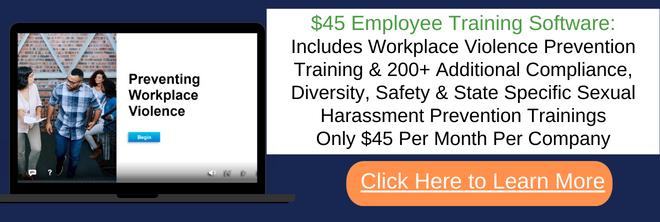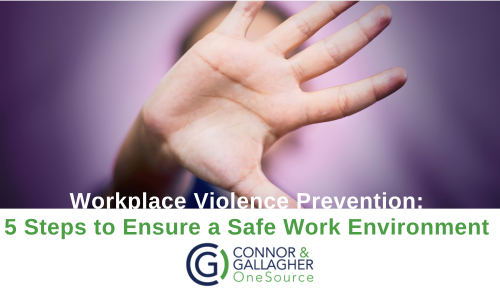OSHA’s definition of workplace violence includes threats and verbal abuse to more extreme scenarios like physical assault and homicide. In this context, workplace violence occurrences are more common than might be expected.
According to SHRM, “nearly half of HR professionals said their organization had at some point experienced a workplace violence incident—up from 36 percent in 2012. And of those who reported having ever experienced workplace violence, over half said their organization had experienced an incident in the last year.”
Sadly, workplace violence is on the rise and it can happen at any occupation so it is essential that organizations take proactive steps to prevent violence from occurring, as well as having clear policies and procedures in place to deal with any incidents that do occur.
This blog provides helpful workplace violence prevention tips by highlighting five key steps employers can take to ensure a safe work environment. By implementing these measures, businesses can help reduce the risk of workplace violence while creating an environment where employees feel secure.
- Establish clear policies and procedures for dealing with violence in the workplace
It is essential for employers to establish clear policies and procedures when it comes to violence in the workplace. These policies should outline what constitutes violent behavior, as well as how employees should respond if they witness or experience any form of violence. Having clear protocols in place will help ensure that incidents are handled appropriately and efficiently whenever they occur.
- Provide training to all staff on how to recognize and respond to signs of potential violence
Training employees in recognizing the warning signs of potential violence can help them intervene before an incident occurs, or if it’s too late for that, alert management quickly so that appropriate action can be taken. Additionally, providing employees with clear guidance on what steps they should take when dealing with incidents of workplace violence will give them the confidence they need to act appropriately and safely in such situations. It is essential that these procedures are communicated clearly and regularly reinforced so that all staff members remain aware of their rights and responsibilities when it comes to preventing violence in the workplace.
If you are looking for a workplace violence prevention training for your employees, our employee training software includes a course you can use for both employees and managers. The training is built to help employees recognize and report troubling behaviors before they escalate and respond effectively to situations. The course also explains what workplace violence is, reviews red-flag behaviors, and outlines the connection between domestic and work violence.
- Encourage open communication between employees, supervisors, and management
Encouraging open communication between employees, supervisors, and management can help staff members feel comfortable talking to their superiors about any issues or concerns they may have regarding potential violence in the workplace and help prevent incidents from occurring in the first place. It also encourages everyone involved to come up with proactive solutions that can help de-escalate any tensions before they become more serious. Furthermore, ensuring that there are clear channels of communication between different levels of management allows for any reports of violent behavior to be addressed quickly and thoroughly.
- Investigate any reports of violent behavior quickly and thoroughly
It is important that employers take any reports seriously and act swiftly in order to address the situation before it escalates. When investigating, employers should look into all aspects of the report including witnesses, evidence, and other relevant information. The investigation should also be conducted with sensitivity towards all parties involved. If necessary, appropriate disciplinary action should be taken in order to ensure that everyone feels secure in their workplace.
- Take appropriate disciplinary action when necessary to ensure a safe work environment for everyone
It is important for employers to be consistent and fair. Employers should have clear policies in place that outline the consequences of violent behavior and make sure employees are aware of these policies. The best approach is one that takes into account all relevant factors such as witnesses, evidence, context, and any mitigating circumstances in order to ensure fairness for all parties involved. In some cases, counseling or other forms of intervention may be necessary before a decision is made regarding disciplinary action. Ultimately, employers must ensure they take appropriate measures when dealing with incidents involving violence in order to create a safe work environment where employees feel secure.
In addition to taking proactive measures to establish clear policies around violence in the workplace and provide training, employers should familiarize themselves with outside resources that may be available to both them and their employees. For example, in the event of a report of violence many Employee Assistance Programs (EAP), often offered as part of the employee benefits package, can be utilized by the employer for coaching a guidance on taking action. Furthermore, the employee can be directed to the EAP for counseling and other resources.
We hope you've found these workplace violence prevention tips to be helpful.
We are here to support you! With our HR Consulting services, our experienced HR advisors can help:
- Audit your existing employee handbook and make policy change recommendations
- Be on call for guidance on escalated HR issues, such as a threat of violence in the workplace
- Help you get setup with our learning management system to assign a workplace violence prevention training to your employees and managers
Request to Speak About HR Guidance Services
Author

Catie Crnkovich, VP of Operations & Sales
Connor & Gallagher OneSource (CGO)
This blog is for educational and/or informational purposes only and does not constitute legal advice.







